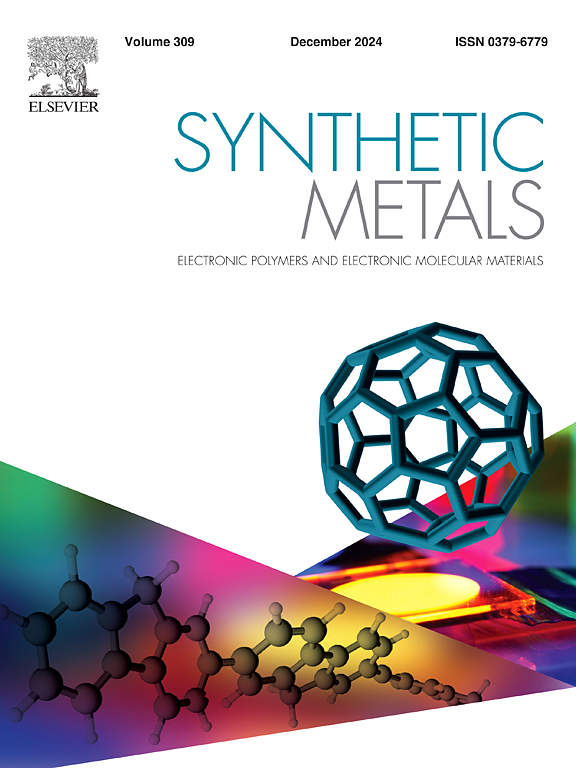Regulating electronic properties of nickel-iron layered double hydroxide with molybdenum disulfide via low-temperature plasma irradiation for efficient overall water splitting
IF 4.6
3区 材料科学
Q2 MATERIALS SCIENCE, MULTIDISCIPLINARY
引用次数: 0
Abstract
Efficient electrocatalysts are essential in water electrolysis for affordable green hydrogen production. Here, by using a low-temperature plasma irradiation method, molybdenum sulfide in-situ formed on nickel iron layered double hydroxide loaded at Ni foam (MoS2/NiFe-LDH@NF) is constructed. X-ray diffraction, scanning electron microscopy and transmission electron microscopy confirm the microstructures of the MoS2/NiFe-LDH networks. X-ray photoelectron spectroscopy proves the formation of active vacancies and electronic regulation between NiFe-LDH and MoS2, which downshifts the d-band level of nickel and iron by 0.24 eV and 0.29 eV, respectively, and thus optimizes the adsorption/desorption equilibrium of intermediates on MoS2/NiFe-LDH, indicated by density functional theory calculations. The resulting MoS2/NiFe-LDH@NF catalyst exhibits high bifunctional activities in the alkaline water splitting. During the hydrogen evolution reaction, remarkably low overpotentials of 85/209 mV are needed to reach 10/50 mA cm⁻², and only 100 mV and 150 mV overpotentials are required during oxygen evolution reaction to achieve 10/50 mA cm⁻², respectively. More importantly, the overall water electrolysis employing MoS2/NiFe-LDH@NF results in a cell voltage of 1.495 V at current density of 10 mA cm−2, lower than that (1.63 V) of the commercially paired IrO2||Pt/C electrocatalyst, accompanied by a long-term stability during 500 h operations. This work demonstrates that the low-temperature plasma irradiation is an effective and simple strategy to prepare robust electrocatalyst for efficient water splitting.
低温等离子体辐照调控含二硫化钼的镍铁层状双氢氧化物的电子性能
高效的电催化剂在水电解中对于经济实惠的绿色制氢至关重要。本文采用低温等离子体辐照的方法,在Ni泡沫(MoS2/NiFe-LDH@NF)负载的镍铁层状双氢氧化物上构建原位形成的硫化钼。x射线衍射、扫描电镜和透射电镜证实了MoS2/ nfe - ldh网络的微观结构。x射线光电子能谱证实了NiFe-LDH和MoS2之间存在活性空位的形成和电子调控,使镍和铁的d带能级分别降低了0.24 eV和0.29 eV,从而优化了MoS2/NiFe-LDH上中间体的吸附/解吸平衡,密度泛函理论计算表明。所得的MoS2/NiFe-LDH@NF催化剂在碱水裂解中表现出较高的双功能活性。在释氢反应中,达到10/50 mA cm⁻²需要85/209 mV的过电位,而达到10/50 mA cm⁻²只需要100 mV和150 mV的过电位。更重要的是,在电流密度为10 mA cm−2的情况下,采用MoS2/NiFe-LDH@NF的整体电解水产生的电池电压为1.495 V,低于商业配对的IrO2||Pt/C电催化剂的电压(1.63 V),并且在500 h的运行期间具有长期稳定性。研究表明,低温等离子体辐照是制备高效水分解电催化剂的一种简单有效的方法。
本文章由计算机程序翻译,如有差异,请以英文原文为准。
求助全文
约1分钟内获得全文
求助全文
来源期刊

Synthetic Metals
工程技术-材料科学:综合
CiteScore
8.30
自引率
4.50%
发文量
189
审稿时长
33 days
期刊介绍:
This journal is an international medium for the rapid publication of original research papers, short communications and subject reviews dealing with research on and applications of electronic polymers and electronic molecular materials including novel carbon architectures. These functional materials have the properties of metals, semiconductors or magnets and are distinguishable from elemental and alloy/binary metals, semiconductors and magnets.
 求助内容:
求助内容: 应助结果提醒方式:
应助结果提醒方式:


